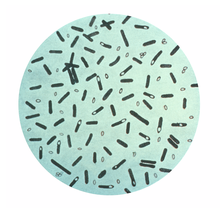Clostridium
| Clostridium | |
|---|---|

| |
Photomicrograph of Clostridium botulinum bacteria stained with crystal violet
| |
| Scientific classification | |
| Domain: | Bacteria |
| Phylum: | Bacillota |
| Class: | Clostridia |
| Order: | Eubacteriales |
| Family: | Lachnospiraceae |
| Genus: | Clostridium Prazmowski 1880 |
| Species | |
|
164 Species | |
Clostridium is a
History
In the late 1700s, Germany experienced several outbreaks of an illness connected to eating specific sausages. In 1817, the German neurologist
Circa 1880, in the course of studying fermentation and butyric acid synthesis, a scientist surnamed Prazmowski first assigned a binomial name to Clostridium butyricum.[3] The mechanisms of anaerobic respiration were still not yet well elucidated at that time, so taxonomy of anaerobes was still developing.[3]
In 1924, Ida A. Bengtson separated van Ermengem's microorganisms from the Bacillus group and assigned them to the genus Clostridium. By Bengtson's classification scheme, Clostridium contained all of the anaerobic endospore-forming rod-shaped bacteria, except the genus Desulfotomaculum.[1]
Taxonomy
As of October 2022, there are 164 validly published species in Clostridium.[4]
The genus, as traditionally defined, contains many organisms not closely related to its
"Clostridium" cluster XIVa (now
Biochemistry
Species of Clostridium are obligate anaerobe and capable of producing endospores. They generally stain gram-positive, but as well as Bacillus, are often described as Gram-variable, because they show an increasing number of gram-negative cells as the culture ages.[11] The normal, reproducing cells of Clostridium, called the vegetative form, are
Clostridium can be differentiated from the also endospore forming genus Bacillus by its obligate anaerobic growth, the shape of endospores and the lack of catalase. Species of Desulfotomaculum form similar endospores and can be distinguished by their requirement for sulfur.[1]
There is a commercially available polymerase chain reaction (PCR) test kit (Bactotype) for the detection of C. perfringens and other pathogenic bacteria.[13]
Biology and pathogenesis
Clostridium species are readily found inhabiting soils and intestinal tracts. Clostridium species are also a normal inhabitant of the healthy lower reproductive tract of females.[14]
The main species responsible for disease in humans are:[15]
- therapeuticuses.
- Clostridium perfringens causes a wide range of symptoms, from food poisoning to cellulitis, fasciitis, necrotic enteritis and gas gangrene.[16][17]
- Clostridium tetani causes tetanus.
- Clostridium difficile, now placed in Clostridioides.
- Clostridium histolyticum, now placed in Hathewaya.
- Clostridium sordellii, now placed in Paeniclostridium, can cause a fatal infection in exceptionally rare cases after medical abortions.[18]
Treatment
In general, the treatment of clostridial infection is high-dose
The vegetative cells of clostridia are heat-labile and are killed by short heating at temperatures above 72–75 °C (162–167 °F). The thermal destruction of Clostridium spores requires higher temperatures (above 121.1 °C (250.0 °F), for example in an
Use
- Clostridium thermocellum can use lignocellulosic waste and generate ethanol, thus making it a possible candidate for use in production of ethanol fuel. It also has no oxygen requirement and is thermophilic, which reduces cooling cost.[citation needed]
- ]
- Botox, which is carefully injected to nerves in the face, which prevents the movement of the expressive muscles of the forehead, to delay the wrinkling effect of aging. It is also used to treat spasmodic torticollis and provides relief for around 12 to 16 weeks.[27]
- Clostridium difficile prophylaxis due to its reported ability to interfere with the growth of the latter.[citation needed]
- débridement of infected wounds.[1] Hyaluronidase, deoxyribonuclease, lecithinase, leukocidin, protease, lipase, and hemolysin are also produced by some clostridia that cause gas gangrene.[11][28]
- synthesis gas, a mixture of carbon monoxide and hydrogen, that can be generated from the partial combustion of either fossil fuels or biomass.[29]
- 1,3-propanediol.[30]
- Genes from endoglucanase. The experiment was intended to learn more about how the digestive capacity of monogastric animals could be improved. [citation needed]
- Nonpathogenic strains of Clostridium may help in the treatment of diseases such as tumors. Clostridium could, therefore, be used to deliver therapeutic proteins to tumours. This use of Clostridium has been demonstrated in a variety of preclinical models.[31]
- Mixtures of Clostridium species, such as Clostridium beijerinckii, Clostridium butyricum, and species from other genera have been shown to produce biohydrogen from yeast waste.[32]
References
- ^ ISBN 978-0-8160-7364-1
- PMID 30238983.
- ^ ISBN 9781345750270.
- Deutsche Sammlung von Mikroorganismen und Zellkulturen. Retrieved 2022-10-03.
- ^ PMID 7981107.
- PMID 26643615.
- ^ a b c Oh, Hyunseok (September 18, 2018). "Taxonomy Of Clostridium Clusters XIVa And IV". eMedicine. EzBioCloud. Retrieved 2021-06-04.
- PMID 25393313.
- PMID 23941657.
- PMID 23941657.
- ^ ISBN 978-0-321-55007-1
- ISBN 978-0-8160-7364-1
- S2CID 86159965
- ISBN 978-0071716727.
- PMID 21413315.
- PMID 30082713.
- PMID 32021965.
- PMID 20879895.
- ISBN 978-1-4200-4479-9
- ISBN 978-3527306732
- ISBN 978-1-4511-1314-3
- ISBN 978-3527306732
- ISBN 978-3527306732
- ISBN 978-3527306732
- ISBN 978-3527306732
- ISBN 978-3527306732
- S2CID 46954613.
- ISBN 978-0-07-159087-7
- ^ "Providing for a Sustainable Energy Future". Bioengineering Resources, inc. Retrieved 21 May 2007.
- S2CID 2896050.
- ISBN 978-1-904455-38-7.
- .
External links
- Clostridium genomes and related information at PATRIC, a Bioinformatics Resource Center funded by NIAID
- Todar's Online Textbook of Bacteriology
- UK Clostridium difficile Support Group
- Pathema-Clostridium Resource
- Water analysis: Clostridium video
